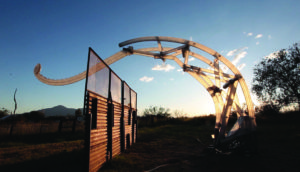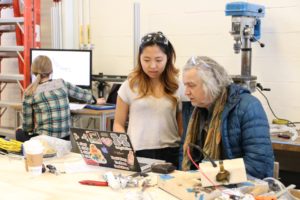More Info
Border Crossers exhibition
Feb. 16–Mar. 23, 2018
Institute for the Humanities Gallery, 202 S. Thayer St.
Gallery Hours: M-F 9 a.m.–5 p.m.
Live Robotic Border Crossers performances
Feb. 16, U-M Museum of Art, 525 S. State St., 4:30 p.m.
Feb. 16, Ingalls Mall, 6:30 p.m.
Special Penny W. Stamps Lecture by Chico MacMurtrie & Artist Reception
Feb. 16, U-M Museum of Art’s Helmut Stern Auditorium (525 S. State St.), lecture at 5:30 p.m., followed by reception at Institute for the Humanities (202 S. Thayer St.) at 6:30 p.m.
Ten years ago, Chico MacMurtrie came up with the idea to create a large-scale robotic artwork that would invite people to rethink the notion of borders in a globalized world.
His artistic vision is being realized at the University of Michigan this semester, where he is working with a team of 16 students to plan, build and launch a 40-foot robotic sculpture that “poetically explores the notion of borders and boundary conditions.”
The robot, which is a lightweight, inflatable, robotic-looking arm, is made to reach up several stories high, arc over a barrier, and bend down to touch on the other side.
According to MacMurtrie, an award-winning artist internationally renowned for making large-scale robotic sculpture, his experiences growing up in Naco, Ariz., which borders Naco, Sonora, Mexico, are central to his work.
“So much has changed in my lifetime—I remember people coming and going across the border through a hole in a fence,” said MacMurtrie. “The border is now fortified, which is kind of senseless and counter-humane in my opinion.”
MacMurtrie is on campus working with students from art and design, engineering, information and LSA as part of an artist residency sponsored by the U-M Institute for the Humanities.
His interdisciplinary project, titled “Border Crossers,” encourages the investigation of borders as constructed entities, both embodying a simple curiosity to see what lies on the other side of a border (national, architectural, environmental, etc.) and expression of a utopian desire to live in a world without borders.
MacMurtrie will launch the work during two “performances”—or demonstrations—this week ahead of his special Penny W. Stamps Lecture at the U-M Museum of Art at 4: 30 p.m. Feb. 16.
It is the second of what the artist hopes will be a total six robots that will perform at international borders.

In 2017, the first “Border Crosser” robot was built and tested at the Amorphic Ranch in Bisbee, Arizona. © MacMurtrie/ARW , Photo by Bobby N. Adams.
“Of course I’ve always envisioned the Mexico-U.S. border as a performance site, but there are many borders that this artwork could connect,” he said. “The robots, to me, represent a peaceful gesture to both start a conversation and to unify people.”
According to Amanda Krugliak, curator at the Institute for the Humanities, the project symbolizes the humanities in action.
“Just being out at the Wilson Center, working in that lab, watching Chico engage with students from different disciplines on campus—it breaks down whatever stereotypes we have about one another based on gender, background or expertise,” she said.
“There are artists fabricating, programmers solving design challenges, and physicists and engineers thinking about creative structural solutions. Just to witness everyone around a table literally trying get this massive thing thing and launched in such a short period of has been truly inspiring.”
A related exhibition, on view Feb. 16–Mar. 23 at the Institute for the Humanities Gallery, will include large-scale drawings that served as plans and maps for MacMurtrie’s “Border Crossers.”

Chico MacMurtrie talks to students at University of Michigan’s Wilson Student Team Project Center. Photo by Robyn Han.
Life-size robotic models will also be presented alongside the drawings. The models, which were built by the all-student team with MacMurtrie’s guidance, were prototypes for the project, offering preliminary steps in the workshop and the process towards realizing the large-scale robotic sculpture.
MacMurtrie’s residency and project are sponsored by the U-M Institute for the Humanities in collaboration with U-M Museum of Art, Michigan Robotics, Michigan Engineering, School of Information, Penny Stamps Speaker Series, Stamps School of Art & Design and ArtsEngine.
MacMurtrie is the artistic director of Amorphic Robot Works, an interdisciplinary creative collective located in Brooklyn, N.Y. MacMurtrie/ARW have received numerous awards for their experimental new media artworks, including five grants from the National Endowment for the Arts, the Andy Warhol Foundation Grant, the Rockefeller Foundation Fellowship, VIDA Life 11.0 and Prix Ars Electronica. MacMurtrie was awarded the Guggenheim Fellowship in Fine Arts in 2016.


